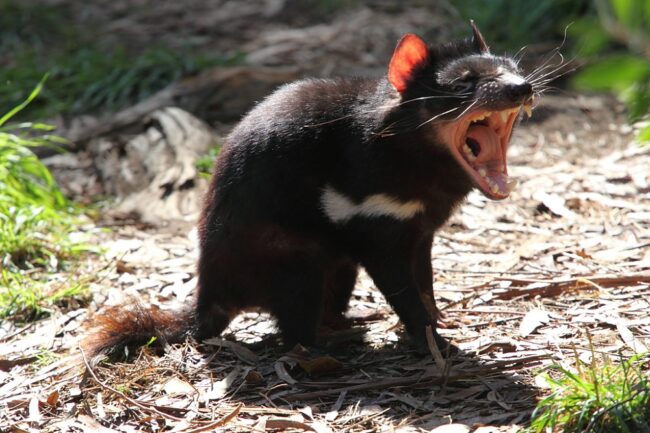Tasmanian devils are small mammals native to the Australian island of Tasmania. Despite only weighing around 10 kilograms, they pack a vicious bite, with the largest bite force-to-body size ratio of any living carnivorous mammal 1. They use these strong jaws to crush bones when feeding and to fight over mates. In 1996, a sick animal was captured and found to have an equally aggressive facial cancer, which was named devil facial tumour disease (DFTD). Interestingly, this cancer was able to spread from diseased to healthy animals through their ferocious biting during social interactions.
Front view of the skull of Tasmanian Devil. Despite their fluffy appearance, they are not cuddly animals! Image from page 164 of “The Cambridge natural history” (1895) [licence: https://www.flickr.com/commons/usage/], via Flickr
It is highly uncommon for cancer to be infectious like DFTD. In fact, only two other directly transmissible cancers are known. Canine transmissible venereal tumour affects dogs and another type was recently discovered in populations of North American clams. Due to its infectious nature, DFTD has spread rapidly and can now be found across Tasmania. It kills almost 100% of infected animals, most within 6 months of contracting the disease. As a consequence, the population of Tasmanian devils has decreased by almost 80% in only 20 years. Until recently, it seemed likely that this aggressive disease would force the ruthless Tasmanian devil into extinction. Models were even developed to estimate how quickly infected populations would die out. Surprisingly, however, some devil populations were able to survive beyond these predictions.
Theoretically, a fast-acting disease affecting an isolated population imposes such strong selective pressure that it can lead to three outcomes. Animal extinction happens when the mortality rate of a disease is so great it wipes out the entire species before any means to combat it can evolve. On the other hand, disease extinction occurs when animals undergo rapid evolution and develop new traits that can fight off the disease, with resistance spreading before the entire population succumbs to it. The third option is that a host-pathogen equilibrium is formed where animals continue to become infected, but can live with the disease and continue to survive and reproduce.
A recent study shed more light on this curious disease and how some Tasmanian devils are able to survive it 2. The researchers compared the DNA samples of almost 300 animals, which were collected from several populations before and after the arrival of DFTD. In the DNA, they looked for patterns of selection to see whether the animals were evolving in response to DFTD, and in which areas of the genome this was occurring. They found two particular genomic regions that seemed to have undergone unusually rapid evolution, suggesting that Tasmanian devils are indeed evolving resistance to the disease. These two regions contained seven different genes, but as the Tasmanian devil is not usually the subject of genomic studies, we do not know much about their genetic make-up. However, as all mammals evolved from a common ancestor around 80 million years ago, they share a large proportion of their genes. This is called homology, and in fact virtually all of our genes are homologous to those in mice and 85% are completely identical! 3
An example of homologous structures are the limbs of vertebrates. By Волков Владислав Петрович (Own work) [CC BY-SA 4.0 (http://creativecommons.org/licenses/by-sa/4.0)], via Wikimedia Commons
To understand how evolution within the two identified genomic regions of the Tasmanian devil could help fight DFTD, the scientists looked at the functions of homologous genes in humans. Of the seven genes, five were directly associated with cancer risk or immune function. Normally, DFTD manages to evade the Tasmanian devil’s immune system, allowing it to persist and spread to other members of the species. Rapid evolution of immune genes suggests that the Tasmanian devil’s immune system is adapting to recognise and fight the disease. Importantly, these five genes were also implicated in the immune response of dogs to canine transmissible venereal tumour, the only other known mammalian transmissible cancer, indicating that they might be key players in fighting this type of cancer. It also suggests that studying these genes more extensively may help us to better understand the nature of transmissible cancers. This is especially true for the other two genes that were not previously linked to cancer in humans, and may have functions specific to DFTD.
The researchers will now use cell lines with different variants of these genes to see how they respond when confronted with DFTD in the lab. They hope to identify a specific set that confer resistance to the disease. If this happens, disease-free Tasmanian devils that are kept in quarantine across the world can then be tested to find individuals with this specific genetic signature. These can then be bred to achieve DFTD-resistant populations, which can be reintroduced to the island in the event that the wild populations are wiped out by the disease. Considering that DFTD has wreaked havoc on the species, like a real-life zombie apocalypse, the findings of this study inspire hope for the survival of the Tasmanian devil. True to their aggressive nature, they are not giving up just yet!
This article was specialist edited by James Burgon and copy edited by Nina Divorty
References
- The National Wildlife Federation wrote a cool article comparing bite power among predators: http://www.nwf.org/News-and-Magazines/National-Wildlife/Animals/Archives/2009/Least-Weasel-Carnivore-Bites.aspx
- You can read the original article describing the research here: http://www.nature.com/ncomms/2016/160830/ncomms12684/full/ncomms12684.html
- For this reason, mice are often used as a model for human diseases in medical research — read more about that here: https://www.genome.gov/10001345/importance-of-mouse-genome/

